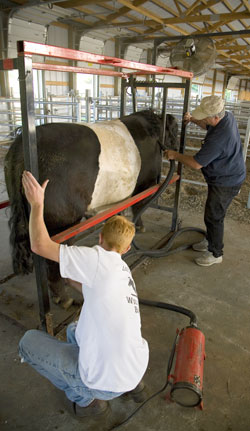An Ancient And Unique History
Today's magnificent Belted Galloways are pure walking history. Descriptions and artistic representations of 'sheeted' cattle first appeared in Scotland as early as the 11th century, and while no precise date of breed origin has been established, Lord David Stuart in his authoritative An Illustrated History of Belted Cattle, claims that:
"The Belted Galloway has maintained its genetic purity and remains a splendid breed apart, still reflecting the unique 'breed standards' first published in 1786: 'The body should be deep and full through the heart with a level top and straight underline; the shoulders fine and straight; the breast full and deep, with the ribs well sprung; the hindquarters long. The flank should be deep and full. The thighs should be deep and fairly straight; the legs short and clean with fine bone, and the tail well set on.'"
 |
A mature 'Beltie' bull of 2000 lb. or more possesses the sturdy power and presence of Scottish 'Highland Cattle' (but without the horns and the great golden brown shaggy coats) melded with the grace and refinement of the Aberdeen Angus, Scotland's primary breed found in the lush lowland meadows of the 'borderlands' with England. The Belties' distinctive double-hair coat enables them to outwinter and forage happily in rigorous climates. In addition they are docile, thrifty and easy to maintain and the dams produce healthy calves well into their teen years with easy deliveries averaging around 70 lbs. at birth.
Sir Ian Hamilton established the first formal UK registry of the breed in 1921 and earlier exports to Canada, the US, Brazil, Kenya, New Zealand and Australia wee recorded during the 1800's and early 1900's. Harry Prock of Philadelphia developed the first US foundation herd in the late 1940's, established the US Belted Galloway Association (later the Belted Galloway Society), and helped create other significant herds throughout the country, including those of A.H. Chatfield Jr.'s Aldermere and General James A. Van Fleet's Withlacoochee and Sleepy Creek herds. Prior to the cessation of English and Scottish exports in 1989 to prevent the spread of BSE (bovine spongiform encephalopathy), over 100 animals had been imported to the USA. At the moment only semen and embryos from the UK are permitted.
Fortunately, the health and purity of current herds in the USA are adequate to maintain stock growth and today, Anderson Hill Farms, winner of numerous awards since 1984, is one of the most notable suppliers of genetics in the USA.
In our hands, the future of the breed is safe and secure!
Key Characteristics of
Belted Galloway Cattle
- Their distinctive white belt, usually stretching from between the shoulders to the hooks, is thought to be an early infusion of Dutch Belted (Lakenvelder) blood in the 17th and 18th centuries, or the now-extinct Sheeted Somerset.
- They have the strong 'landrace' characteristics of a breed ideal for the rugged terrain of Scotland - and similar topography in Vermont
- A thick double hair coat is ideal for survival and outwinter foraging in harsh climates
- Belties are a remarkably thrifty breed due to their strength, longevity, durability and foraging abilities in all seasons, their general ease of maintenance, and their ability to reach full weight on grass without grain 'finishing.'
- Dams produce healthy, strong calves well into their teen years of lightweight birth (around 79 lbs.) enhancing easy deliveries even in first-calf heifers.
- Their milk is heavier and richer than most breeds and thus the calves do exceedingly well
- The breed is noted for its growth to mature bulls of 1700-2300 lbs. and cows between 1000-1500 lbs. An average steer can produce the ideal 600-750 lb. carcass with a dress ratio of up to 65%
- Belties are 'survivors' as indicated by numerous records of their remarkable endurance in floods, hurricanes and blizzards
- "Beltie beef is the best in the world," according to many gourmet-writers (including Giles MacDonogh in London's Financial Times, September 2000) and even the 16th century historian, Hector Boece who proclaimed "their flesh is right delicious and tender."
- Belties tend to be unusually docile and bulls are rarely troublesome but can be courageously assertive if threatened.
- "On marginal land they are unrivaled...there is no other breed worth more the pound weight than a first-class Galloway." (William McCombie - pioneer Scottish Angus and Shorthorn breeder)
- The Galloway ranks second only to the buffalo in minimal fat and high meat density tests (Canadian Government Experiential Station)
- Belties top the chart for flavor, juiciness and tenderness according to USDA, GPE, MARC and other tests
- Despite their thick double coats, Belties adapt readily to a wide range of environmental conditions
- Belties are extremely cost-effective in terms of disease-resistance; high and long breeding rate; feed versus dressed meat; live weight versus dressed; larger key cuts and less waste fat (due particularly to double coat insulation)
|



